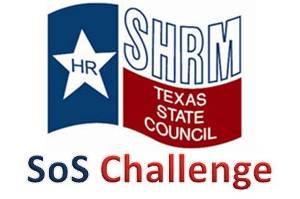HR Matters
Texas SHRM
Submit the Chapter Leader Information Form (online) showing the FULL list of council members with all contact information no later than 12/1; late submissions may cause your chapter to be ineligible for a SHAPE award. If you don’t know your full council yet, submit what you have by 12/1 and submit the rest later.
Sherry Birkhold: Winner
The process to offer your support couldn't be easier. Sign the Challenge today!

We hope you will plan to attend the SHRM-TSC Global Conference, January 16, 2013 in Houston.
Who should attend?
This conference is designed for all size companies that deal with questions regarding hiring foreign nationals or sending employees to work in other countries for short-term or long-term projects. Many of our attendees will have responsibilities for HR outside of the US, requiring knowledge of HR functions in several countries. No matter which of these areas are of greatest focus for the prospective attendee, their organizations must develop globally experienced employees trained to take advantage of expanding global markets.
There will be something for everyone at the conference and we look forward to you joining us for a fun day of education.
To learn more about the conference log on to www.tscglobalconference.org
If you are a member of the SHRM-Texas State Council then we hope you will plan to attend our meeting in January in Houston on January 25th and 26th.
This meeting is focused on orientation for Chapter Presidents. All official members of the Texas State Council are invited. Also invited is one additional member of the chapter leadership who is responsible for the execution of the operations for the chapter. This meeting will dive into the operations of the SHRM-TSC with how the Council can support and help the chapters – announce SHRM-TSC goals and Committee Goals details.
To register and find out more information about the meeting log on to http://texas.shrm.org
SHRM e-learning benefits HR professionals at all career levels. We provide the tools and education to elevate HR professionals and transform them into strategic business partners.
SHRM e-learning also provides online compliance training for your employees and managers. SHRM's compliance training courses help employers establish defenses to potential workplace litigation and emphasize both risk management and education.
As a user, you will benefit from a wealth of knowledge, an abundance of recertification credits and all the support you need. So log in, purchase some credits and redeem them for one of the most thorough and informed educational experiences you and your employees and managers ever encountered.
Click here for more information about registration.
Please use registration code: TXSHRMSC.
Each month the SHRM-TSC will randomly place the name of one of our chapter members in the newsletter. When you find your name (which will have the word "Winner" typed beside it) simply email Dena Culpepper at the Council office (denaculpepper@att.net) and she will send you your prize. Thanks for reading!
Traveling around the State of Texas, there has been a consistent theme that I have noticed – How do I engage employees? O.K., so you’re not SAS (world's largest privately held software company and #1 in employee engagement), where free on-site medical care for employees and their families, low-cost high quality child care, a fitness center, library, and summer camp for children of employees, are the norm. Or Goggle where they’ve got it all: free food, fitness facilities, massage rooms, hair dressers, laundry rooms and on-site doctors. So what are you to do?
First, you have to understand what employee engagement is and the impact that the lack of employee engagement can have on your company or business.
Wikipedia defines "employee engagement" as the extent to which employee commitment, both emotional and intellectual, exists relative to accomplishing the work, mission, and vision of the organization. Engagement can be seen as a heightened level of ownership where each employee wants to do whatever they can for the benefit of their internal and external customers, and for the success of the organization as a whole.
Employee engagement has become an area of focus within organizations for the purpose of retention as a means of avoiding expensive employee replacement costs resulting from staff who voluntarily quit their jobs.
[1] According to SHRM (Society of Human Resource Management) the cost of replacing one $8 per hour employee can exceed $3,500, which gives companies a strong financial incentive to maintain their existing staff members through strong employee engagement practices.
[2] Now, it does not take a rocket scientist to figure out that the impact is significant; more importantly, it is not an issue that can continue to be avoided especially with the diverse workforce that we have in today’s workplace.
Many businesses and organizations get caught up in the:
Inappropriate use of Benchmark Data - some of the more well established employee engagement survey companies will state that the most important part of post-survey follow up is related to comparison of internal survey data to numerous external benchmarks. This seems to have rubbed off onto internal sponsors who demand very specific benchmarks. While some research analysts claim that the standard comparisons by industry sector are flawed others disagree. Is it right to compare a Bentley employee to one from Vauxhall (GM) because they are in the same automotive sector? The alternative argument is that both organizations would likely draw from similar worker pools and would as such wish to better understand expectations of workers in that industry and how they compare to competing employers.
A focus on data gathering rather than taking action may also damage engagement efforts. Organizations that survey their workforce without acting on the feedback appear to negatively impact engagement scores.
[4] According to the Conference Board and other recent studies, employee engagement has deteriorated significantly in the US over the last five years. Measuring and managing the wrong or incomplete set of engagement drivers is partly, if not mostly, to blame. While it is possible to measure engagement itself through employee surveys, this does not assist in identifying areas for improvement within organizations. There are a range of factors, known as drivers that are thought to increase overall engagement. By managing the drivers, an organization can effectively manage engagement levels of its employees. Drivers such as communication, performance clarity and feedback, organizational culture, rewards and recognition, relationships with managers and peers, career development opportunities and knowledge of the organization’s goals and vision are some of the factors that facilitate employee engagement.
Some key points from the research are presented below:
· * Employee perceptions of job importance - According to a 2006 study by Gerard Seijts and Dan Crim, "...an employee's attitude toward the job's importance and the company had the greatest impact on loyalty and customer service than all other employee factors combined."[15] ·
* Employee clarity of job expectations - "If expectations are not clear and basic materials and equipment are not provided, negative emotions such as boredom or resentment may result, and the employee may then become focused on surviving more than thinking about how he can help the organization succeed."[7] ·
* Career advancement/improvement opportunities - "Plant supervisors and managers indicated that many plant improvements were being made outside the suggestion system, where employees initiated changes in order to reap the bonuses generated by the subsequent cost savings."[16] ·
* Regular feedback and dialogue with superiors - "Feedback is the key to giving employees a sense of where they’re going, but many organizations are remarkably bad at giving it."[7] " 'What I really wanted to hear was 'Thanks. You did a good job.' But all my boss did was hand me a check.'"[12] ·
* Quality of working relationships with peers, superiors, and subordinates - "...if employees' relationship with their managers is fractured, then no amount of perks will persuade the employees to perform at top levels. Employee engagement is a direct reflection of how employees feel about their relationship with the boss."[15] ·
* Perceptions of the ethos and values of the organization - "'Inspiration and values' is the most important of the six drivers in our Engaged Performance model. Inspirational leadership is the ultimate perk. In its absence, [it] is unlikely to engage employees."[12] ·
* Effective Internal Employee Communications - which convey a clear description of "what's going on". "'If you accept that employees want to be involved in what they are doing then this trend is clear (from small businesses to large global organizations). The effect of poor internal communications is seen as its most destructive in global organizations which suffer from employee annexation - where the head office in one country is buoyant (since they are closest to the action, know what is going on, and are heavily engaged) but its annexes (who are furthest away from the action and know little about what is happening) are disengaged. In the worst case, employee annexation can be very destructive when the head office attributes the annex's low engagement to its poor performance... when its poor performance is really due to its poor communications. ·
* Reward to engage - Look at employee benefits and acknowledge the role of incentives. "An incentive to reward good work is a tried and test way of boosting staff morale and enhancing engagement." There are a range of tactics you can employ to ensure your incentive scheme hits the mark with your workforce such as: Setting realistic targets, selecting the right rewards for your incentive program, communicating the scheme effectively and frequently, have lots of winners and reward all achievers, encouraging sustained effort, present awards publicly and evaluate the incentive scheme regularly. [17] The payoff shows up in increased innovation and productivity, lower turnover, lower sickness rates, and higher employee satisfaction. In a world warring for increasingly sparse talent, a strong engagement program should not to be underestimated. My parting question to you is – What type of engagement program do you have?
References available at http://en.wikipedia.org/wiki/Employee_engagement





